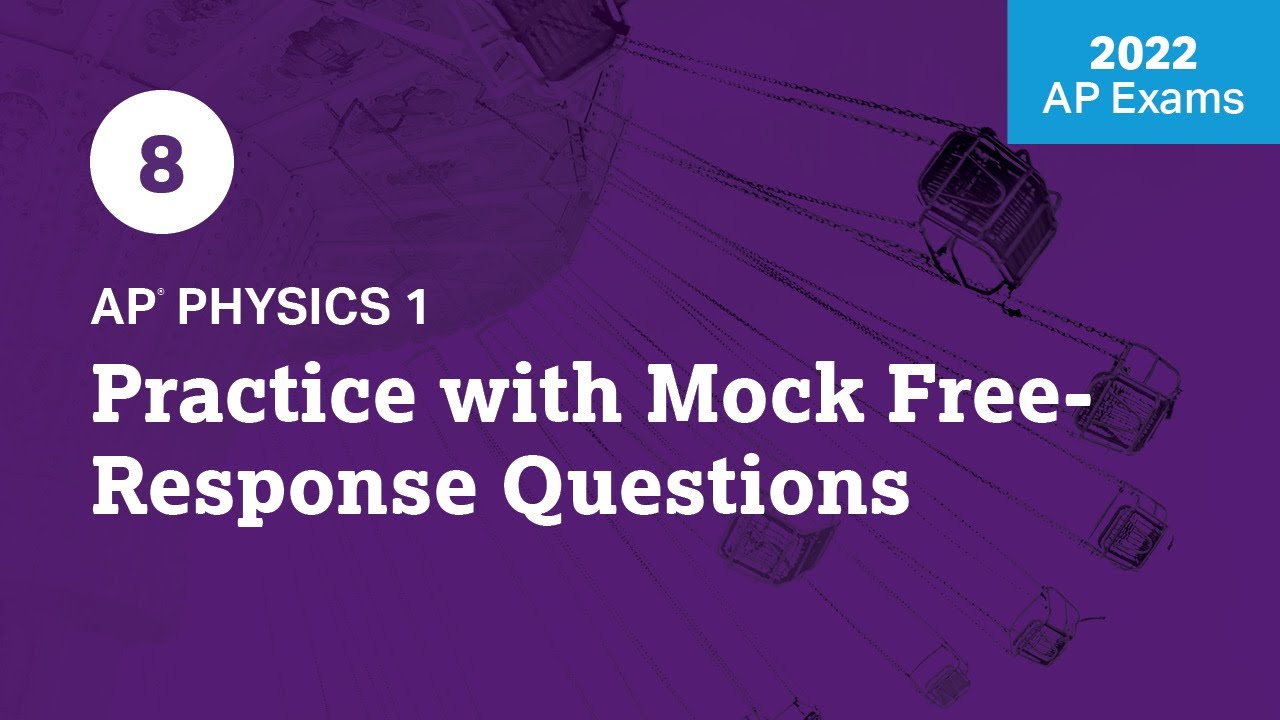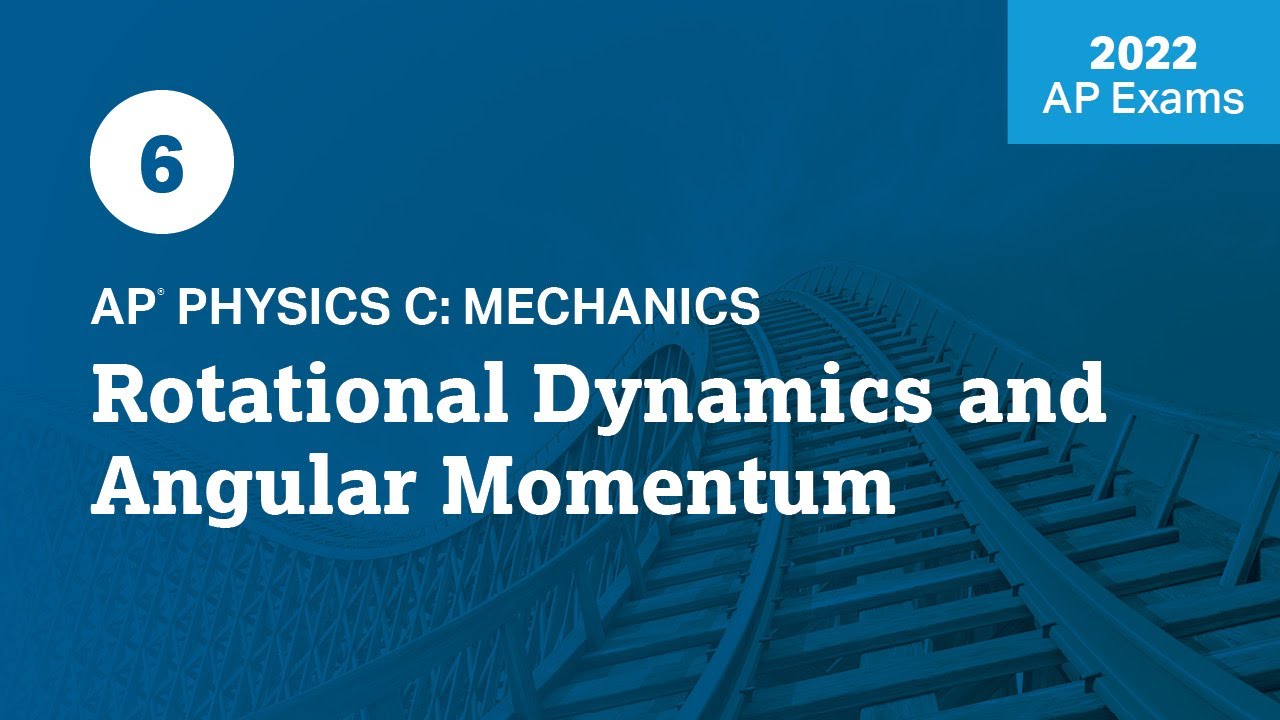6 | FRQ (Question 2: Qualitative/Quantitative Translation) | Practice Sessions | AP Physics 1
TLDRKristen Gonzalez-Vega from Frisco, Texas, leads an engaging AP Physics 1 practice session focusing on qualitative/quantitative questions. She discusses a scenario involving a rod and a disk, exploring the principles of angular momentum and torque to determine the point at which the disk should hit the rod to achieve maximum angular speed. The session emphasizes the importance of understanding physics concepts and relationships, rather than just manipulating equations, and provides strategies for answering multiple-choice questions on the AP exam effectively.
Takeaways
- 📚 The session focuses on AP Physics 1 free-response questions, specifically a qualitative/quantitative question type.
- 🎯 The main problem involves a rotating rod with a disk traveling towards it, aiming to maximize angular speed.
- 🤔 In qualitative analysis, understanding torque (R cross F) and angular momentum conservation is crucial for solving the problem.
- 📈 For quantitative analysis, the relationship between torque and distance from the pivot point determines the change in angular velocity.
- 🔄 The greatest torque and thus angular speed result from striking the rod at a point farthest from the pivot, due to the increased leverage.
- 🚫 The AP exam does not award points for correct answers without proper explanations based on physics principles.
- 🔧 In part B, students must evaluate the plausibility of an internet-sourced equation, focusing on the relationships between variables rather than the equation itself.
- ✅ Consistency in reasoning is rewarded; however, an incorrect initial choice negates the possibility of earning points for reasoning.
- 📊 For part C, students critique an implausible equation by focusing on functional dependence and the relationships between angular velocity, mass, and inertia.
- 🧠 In part D, a correct derivation using the conservation of angular momentum is required, with emphasis on the initial and post-collision angular momenta.
- 🛑 In part E, the scenario changes to include the disk bouncing off the rod, which alters the angular momentum and velocity outcomes due to the change in momentum direction.
Q & A
What is the main topic of the AP Daily practice session presented in the transcript?
-The main topic is the discussion and analysis of a qualitative/quantitative (QQT) question in AP Physics 1, focusing on the concepts of angular momentum and torque.
What type of question are they analyzing in the practice session?
-They are analyzing a QQT question that involves a rod pivoted about one end and a disk traveling towards it, with the goal of determining where to aim the disk for maximum angular speed.
What is the significance of the point C mentioned in the transcript?
-Point C is a reference point on the rod where the disk can be aimed to achieve different outcomes in terms of angular speed and torque applied.
How does the distance from the pivot point (R) affect the torque and angular velocity?
-The torque is directly proportional to the distance from the pivot point (R), meaning a larger distance results in a greater torque, which in turn leads to a greater change in angular velocity.
What is the relationship between torque (R cross F) and angular momentum?
-Torque is related to angular momentum in that a larger torque, resulting from a greater force applied at a distance from the pivot (R), can lead to a larger change in angular momentum and thus a greater angular velocity.
What is the key principle behind the student's task in part B of the transcript?
-The key principle is to evaluate whether a given equation from the internet is consistent with the physical situation described in part A, without manipulating the equations but rather analyzing the relationships between variables.
How does the student determine if the equation provided in part B is consistent with their reasoning?
-The student looks at the relationships between the variables in the equation, such as the distance from the pivot (x) and angular velocity (omega), to determine if the equation supports their reasoning from part A.
What is the main issue with the equation presented in part C of the transcript?
-The main issue is that the equation incorrectly includes the mass of the disk (m) in the denominator, which does not make physical sense as the mass should not be inversely related to angular velocity in this context.
How does the conservation of angular momentum principle apply to the scenario in part D?
-The conservation of angular momentum principle is used to derive the correct expression for omega (angular velocity) by considering the initial and final angular momenta of the system, which includes the disk and the rod after the collision.
What is the expected outcome in terms of angular velocity if the disk bounces back off the rod as described in part E?
-If the disk bounces back off the rod, the system's angular momentum changes direction (from positive to negative), and to conserve angular momentum, the rod must rotate with a greater angular velocity to balance out the negative momentum.
What is the importance of understanding the relationships between variables in physics?
-Understanding the relationships between variables is crucial in physics as it allows for the correct analysis and prediction of outcomes in various scenarios, such as determining the effects of torque and angular momentum on angular velocity.
Outlines
🌟 Introduction to AP Physics 1 Qualitative/Quantitative Question
Kristen Gonzalez-Vega introduces the session on AP Physics 1, focusing on a qualitative/quantitative question type. She encourages downloading the question for reference and emphasizes the importance of understanding the concepts of torque, angular momentum, and their relationship with angular velocity. The session aims to help students tackle free-response questions effectively by discussing the dynamics of a rod and disk system, specifically where to aim the disk for maximum angular speed. The key takeaway is that the greatest torque, which is proportional to the distance from the pivot point, results in the greatest angular velocity.
📚 Analysis of a Given Equation in Relation to the Problem
In this segment, the discussion revolves around evaluating an equation found on the internet and determining its relevance to the problem at hand. The equation's relationship with the established physical concepts is scrutinized, particularly how it relates to the mass of the disk, distance from the pivot, velocity, and inertia. The focus is on understanding the direct and inverse relationships between these variables and the angular velocity (omega). The scoring guidelines for this part emphasize the importance of consistency between the equation and the physical principles discussed, rewarding points for a clear understanding and application of these relationships.
🔍 Critical Evaluation of an Equation's Plausibility
This paragraph involves a critical examination of an equation's plausibility without deriving it from scratch. The analysis is based on the functional dependence of angular velocity on variables such as mass, rotational inertia, and distance from the pivot. The goal is to identify any inconsistencies in the equation by comparing it to the known physical relationships. The scoring guidelines for this section award points for focusing on the relationships between variables, addressing the mass or inertia, and concluding the equation's correctness based on these relationships.
📝 Derivation of Omega Using Conservation of Angular Momentum
The focus of this section is on deriving the expression for angular velocity (omega) using the principle of conservation of angular momentum. The process involves starting with a basic equation and making at least one substitution to account for the disk's and rod's properties. The derivation includes combining the rotational inertias of the rod and disk and ensuring the use of correct terms and variables. The scoring guidelines for this part emphasize the importance of using the conservation of angular momentum, indicating the initial and post-collision angular momentum, and understanding the total angular momentum of the system.
💡 Impact of Disk Bounce on Angular Velocity
The final part of the script discusses a scenario where the disk bounces off the rod instead of sticking to it. The change in angular momentum due to the disk's change in direction is analyzed, and its effect on the rod's angular velocity is explored. The key point is that the rod will have a greater angular velocity to balance the negative angular momentum resulting from the bounce. The scoring guidelines for this section reward points for understanding the change in the disk's angular momentum, applying the conservation of angular momentum principle, and explaining the resulting increase in the rod's angular velocity.
Mindmap
Keywords
💡AP Physics 1
💡Qualitative/Quantitative Question (QQT)
💡Angular Speed
💡Torque
💡Conservation of Angular Momentum
💡Rotational Inertia
💡Collision
💡Physics Relationships
💡Equations
💡Scoring Guidelines
💡Derivation
Highlights
Kristen Gonzalez-Vega from Frisco, Texas introduces the AP Physics 1 practice session focusing on free-response questions.
The session specifically addresses a qualitative/quantitative question type, requiring an understanding of both physical concepts and numerical values.
A key question involves determining where to aim a disk traveling towards a pivoted rod to maximize angular speed.
The concept of torque, defined as the product of the radius and force (R cross F), is crucial for solving the problem.
The importance of angular momentum conservation in physics problems is emphasized, particularly in relation to the rod and disk scenario.
Gonzalez-Vega explains that the greatest torque, and thus angular velocity, results from the greatest distance from the pivot point where the force is applied.
The session highlights the need for a detailed explanation in AP exams, not just the correct answer, to earn credit.
An example is provided on how to evaluate an equation's relevance to the problem without extensive mathematical manipulation.
The importance of consistency between the chosen answer and the explanation is stressed, as inconsistency can lead to point deduction.
Gonzalez-Vega discusses how to identify an incorrect equation based on its physical plausibility rather than just mathematical derivation.
The concept of rotational inertia and its relationship with angular momentum and velocity is explored.
A step-by-step derivation of the correct expression for angular velocity (omega) is provided, emphasizing the use of conservation of angular momentum.
The session explains how the outcome of the disk bouncing off the rod, as opposed to sticking to it, affects the angular velocity.
The practical application of these physics concepts is demonstrated through the use of a real-world scenario involving a rod and a disk.
The importance of using the correct physical relationships and not just mathematical formulas is stressed for problem-solving in the AP exam.
Gonzalez-Vega provides guidance on how to approach multiple-choice questions in a way that demonstrates understanding of the physical concepts involved.
The session concludes with a summary of the key points and an encouragement for students to apply these strategies in their AP Physics 1 exam preparation.
Transcripts
Browse More Related Video

1 | MCQ | Practice Sessions | AP Physics 1

5 | FRQ (Question 2: Qualitative/Quantitative Translation) | Practice Sessions | AP Physics 1

3 | FRQ (Question 1: Experimental Design) | Practice Sessions | AP Physics 1

2022 Live Review 8 | AP Physics 1 | Practice with Mock Free-Response Questions

2 | FRQ (Question 4/5: Short Answer) | Practice Sessions | AP Physics 1

2022 Live Review 6 | AP Physics C: Mechanics | Rotational Dynamics and Angular Momentum
5.0 / 5 (0 votes)
Thanks for rating: